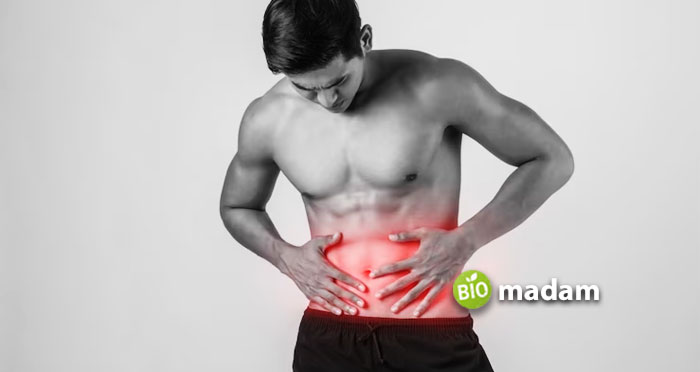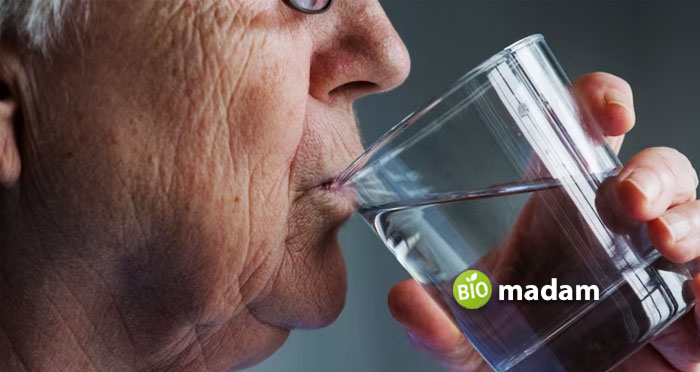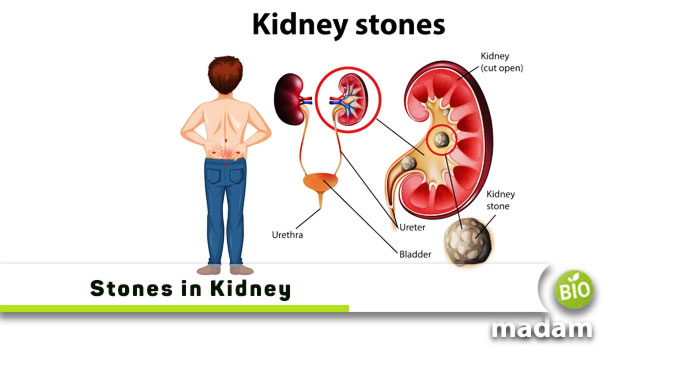If you have had severe pain in your back or side for a few days now, you might have a kidney-related issue. And kidney stones are one of the most common renal health problems. When you visit a doctor with symptoms like severe back pain or blood in urine, they will ask you to get tested for kidney stones. Thus, a kidney stone size chart helps understand the size of the kidney stone and offer the right treatment regimen. This article tells you everything you need to know about kidney stones and their sizes.
What are Kidney Stones?
Kidney stones or renal calculi are hard accumulations of crystalized minerals in the kidney; they are also known as Nephrolithiasis. They result from the aggregation of unwanted toxic substances or a decrease in urine volume. Dehydration is among the major causes of mineral accumulation and kidney stones. They typically form in the kidney and travel to the bladder and urethra. The normal functioning of kidneys disturb and the patient gets severe pains when experiencing kidney stones.
What are Kidney Stones Made of?
Kidney stones may form from calcium, cysteine, or uric acid. They could be brown or yellow, small or large in size, depending on their composition. Mostly, the stones pass through the urinary tract when you urinate. However, sometimes kidney stones are too large (as much as the size of a golf ball) to pass through the urethra and require surgery. Generally, patients experience excruciating pain resulting from kidney stones.
| Stone Composition | Shape | Occurrence | Cause |
| Calcium oxalate | Envelop or dumbbell | 80% | 🡩 calcium and oxalate |
| Uric acid | Diamond | 10% | 🡩 uric acid and urine pH |
| Struvite | Coffin-lid | 10% | 🡩 urine pH |
| Calcium phosphate | Amorphous | 5% or less | 🡩 urine pH and calcium |
| Cystine | Hexagonal | 1% or less | Genetic disorder |
Symptoms of Kidney Stones
The kidney stones symptoms may vary from individual to individual. Yet, some of the common signs and symptoms in kidney stone patients include:

- Pain in the lower abdomen
- Pain below the ribs, in the back, or side to side
- Pain during urination
If the condition worsens, you may also experience the following symptoms:
- Unusual urine smell
- Bleeding during urination
- Fever in case of a urinary tract infection
Kidney Stones Risk Factors
The following factors increase your risk for kidney stones:
- Dehydration
- Obesity
- Diabetes
- High blood pressure
- High protein, sugar, or salt diet
- Family history
Kidney Stone Size Chart
A kidney stone size chart allows you to understand the characteristics of a kidney stone according to its size. Furthermore, it details the time required for the stone to pass through the urinary tract and suitable treatment option.
This chart in “mm” and “cm” mentioned below tells the severity of symptoms, chances of passing stones naturally, kidney stones treatment, and time required to pass naturally.
| Kidney Stone Size | Chances of Passing Naturally | Treatment | Pain During Passing Naturally | Time Required to Pass Naturally (average) |
| < 2 mm | 80% | Increased hydration | Passes without pain | 8 days |
| 2-4 mm | 80% | Increased hydration + home remedies | Passes without pain | 12 days |
| 4 mm | 80% | Increased hydration + home remedies | Slightly disturbing | 31 days |
| 4-7 mm | 60% | Increased hydration + painkillers | Painful | 45 days |
| > 7 mm | 20% | Ureteroscopy | Very painful | 12 months |
| 1-2 cm | Cannot pass naturally | Lithotripsy | Extremely painful | — |
| > 2 cm | Cannot pass naturally | Percutaneous nephrolithotomy | Painful with other complications | — |
Kidney Stones Treatment
Wait-And-See
This is the most common approach when it comes to kidney stone treatment. If you are not in severe pain, your doctor will suggest you wait as the stone might pass through urine. However, it requires understanding the kidney stone size chart and providing adequate pain management drugs.
Dissolution Medication
The next step is to prescribe medication to help dissolve kidney stones. It makes it easy for kidney stones to pass through the urinary tract. The stones break into smaller fragments and pass through the urinary tract with less pain.
Ureteroscopy
Ureteroscopy involves inserting a camera attached to a thin tube up the urinary tract to examine the stone. It is typically used for stones in the lower urinary tract or the ureter.
ESWL
Extracorporeal Shock Wave Lithotripsy, or ESWL, is a non-invasive procedure that breaks larger kidney stones into smaller pieces for easy removal. This procedure helps with stones in the upper urinary tract, which can be quite painful as they move down.
Percutaneous Nephrolithotomy
Percutaneous Nephrolithotomy, or PCNL, is a surgical procedure that involves a small incision in the back to remove stones. Doctors opt for PCNL in case of large kidney stones that cannot pass through the urinary tract.
Which Kidney Stones can Pass Naturally?
Kidney stones smaller than 4 mm can easily pass through the urinary tract. While a stone of up to 4 mm might be discomforting, smaller ones will pass out without any pain.
The chances of kidney stones less than 4 mm passing through the urinary tract naturally lie above 80%, whereas stones between 4 mm and 7 mm have a 60% chance. Also, the time taken for each type of stone varies, as the kidney stone size chart indicates.
While the time taken for a kidney stone to pass through the urine naturally depends on the size of the stone, other factors like age and medical diseases or conditions may also influence when the stone moves out naturally.
Larger stones typically hurt more when passing naturally. However, the doctor usually prescribes you painkillers so it does not hurt much. Sometimes, doctors also give medications to break larger stones into smaller ones; it all depends on the overall condition.

How do I know I Passed Kidney Stones Naturally?
Though the kidney stone size chart shows small kidney stones do not cause pain when exiting the body, you may have the following symptoms when you pass a kidney stone:
Nausea and Vomiting: When your body goes through a stressful episode, it results in nausea and vomiting, and you might feel the same when passing kidney stones. So, the process might not be accompanied by pain, yet it can make you feel sick.
Cloudy Urine: When kidney stones are eliminated from your body with the urine naturally, the fragments make the urine cloudy and foul-smelling; it may also seem darker than usual due to the stone.
Discomfort during Urination: You might not feel excruciating pain, but you will experience slight pain or discomfort in the back and the abdomen region. It also leads to the urgency to urinate, followed by painful urination.
Blood in Urine: Passing blood in urine may be associated with passing kidney stones, but it is not a good sign. So, you should get yourself evaluated if you see pinkish or red spots in your urine; it could indicate other related issues involving the kidneys, bladder, or prostate.
High Fever: Some people also show symptoms like high fever and chills before passing kidney stones. Thus, you must report your symptoms to the doctor so he can prescribe suitable medication.
Kidney Stones Passing Naturally Men Vs. Women
The occurrence of kidney stones in males is higher than in females. However, pregnant and middle-aged women have a higher risk of kidney stones. The signs and symptoms of kidney stones passing in men and women can be different.
Usually, men do not feel symptoms when passing kidney stones except pain in the back and testicular region. Sometimes, they might not feel any kind of pain. At the same time, females experience more severe pain in the back, abdomen, and pelvis, vomiting, nausea, blood in urine, and color changes. Females may also experience urinary tract infections when they have kidney stones.
Home Remedies for Kidney Stones
While you must always visit your doctor when you experience any symptoms of kidney stones, a few home remedies can help. But you must consult a healthcare worker before adding them to your routine.

Lemon Juice
Lemon juice has high concentrations of citrate that may contribute to stopping kidney stone formation; other citrus fruits like oranges and limes may also help.
Coffee
Research also shows a connection between coffee and kidney stone prevention. So, if you are a coffee lover, you may be able to avoid stones. But do not increase your coffee intake suddenly.
Apple Cider Vinegar
Apple cider vinegar is also said to alter your urine’s pH, eventually preventing kidney stone formation. Yet, there are no strong references about vinegar actually helping with avoiding kidney stones.
How to Avoid Kidney Stones?
Drinking enough water to avoid dehydration is the best way to prevent kidney stones. Additionally, following a DASH diet and managing your salt intake may reduce your risk of kidney stones. Moreover, if you have had kidney stones previously, your doctor may tell you what you should avoid, particularly animal protein, sodium, or oxalate.
Sometimes patients reduce calcium intake without inquiring about the underlying cause. Suddenly reducing calcium may lead to calcium deficiency. So, always consult your doctor so they can tell you better.
For example, kidney stones resulting from cysteine cannot be avoided by regulating your calcium intake; it is a genetic disorder that requires raising the pH level of your urine to alleviate the condition.
The Bottom Line
Kidney stones result from the accumulation of minerals like calcium oxalate, uric acid, struvite, calcium phosphate, and cysteine. They may be smaller in size (less than 4 mm) or larger (2 cm or more). Thus, the kidney stone size chart helps you understand the preferred treatment regimen and the chance of the stone passing naturally according to its size. Kidney stones smaller than 4 mm pass without severe pain but larger stones, usually measuring in centimeters, cannot pass naturally; doctors remove them surgically.
FAQs
Which type of kidney stones do I have?
Once your doctor suspects you may have kidney stones, they will conduct further diagnostic tests like blood tests or urine analysis to understand the type of kidney stones. Moreover, imaging tests like X-rays and CT scans help identify the size of the stone, while blood and urine tests facilitate the identification of minerals and compounds in your blood or urine. Usually, kidney stone patients have elevated phosphorus, oxalate, or calcium levels in their test results.
Are kidney stones hereditary?
If you have seen multiple people in your family get kidney stones and wonder if they are genetic, they can be. Hereditary stones, especially from cystine accumulation, can be genetic and pass from generation to generation.
What are the 3 most common types of kidney stones?
Calcium oxalate, uric acid, and struvite kidney stones are the most common among all types. Calcium oxalate stones have the highest occurrence, accounting for around 80% of all kidney stone cases. They result from the combination of oxalate and calcium. Meanwhile, uric acid stones result from meat and food with high purine levels.
Can kidney stones go unnoticed?
Having a kidney stone for years is possible before you feel pain. Small kidney stones may be in your kidneys for years, but you will not feel any pain until they move out of the kidney. You might not know, but you can have different kidney stones at once. If you have had kidney stones more than once, a urine analysis may help your doctor understand the risks and how soon you develop them.

Hello, I would like to introduce myself to you! I am Chelsea Rogers, an experienced blog writer for science articles, holding an MPhil degree. My enthusiasm to grab the best knowledge, let it relate to botany, zoology, or any other science branch. Read my articles & let me wait for your words s in the comment section.

